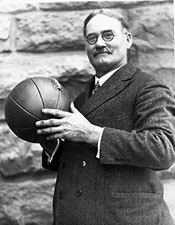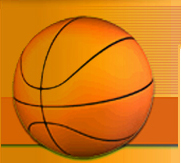 Basketball, is a game that in thee beginning started with 18 men in a YMCA gymnasium in Springfield, Mass. Basketball has grown into a game with more than 300 million people playing it worldwide. Basketball was created by Dr. James Naismith (pictured here). Under orders from Dr. Luther Gulick, the head of Physical Education at the School for Christian Workers, Naismith was given 14 days to create an indoor game that would provide an "athletic distraction" for a rowdy class through the brutal New England winter. Naismith's invention didn't come easily. His first intention was to bring outdoor games indoors, i.e., soccer and lacrosse. These games proved too physical and cumbersome. At his wits' end, Naismith recalled a childhood game that required players to use finesse and accuracy to become successful. After brainstorming this new idea, Naismith developed basketball's original 13 rules and consequently, the game of basketball. Basketball, is a game that in thee beginning started with 18 men in a YMCA gymnasium in Springfield, Mass. Basketball has grown into a game with more than 300 million people playing it worldwide. Basketball was created by Dr. James Naismith (pictured here). Under orders from Dr. Luther Gulick, the head of Physical Education at the School for Christian Workers, Naismith was given 14 days to create an indoor game that would provide an "athletic distraction" for a rowdy class through the brutal New England winter. Naismith's invention didn't come easily. His first intention was to bring outdoor games indoors, i.e., soccer and lacrosse. These games proved too physical and cumbersome. At his wits' end, Naismith recalled a childhood game that required players to use finesse and accuracy to become successful. After brainstorming this new idea, Naismith developed basketball's original 13 rules and consequently, the game of basketball.
Dr. James Naismith was the first and foremost a physical educator who loved recreational sport but shied away from the glory of competitive athletics. Naismith was an intense student, collecting four degrees in the diverse fields of Philosophy, Religion, Physical Education and Medicine. Although he never had the opportunity to see the game become the astonishing spectacle it is today, Naismith's biggest thrill came when he was sponsored by the National Association of Basketball Coaches (NABC) to witness basketball become an Olympic sport at the 1936 Games held in Berlin. Naismith became famous for creating the game of basketball, a stroke of genius that never brought him fame or fortune during his lifetime, but enormous recognition following his passing in 1939. For his historic invention, Naismith's name adorns the world's only Basketball Hall of Fame in Springfield. Mass, a tribute that forever makes James Naismith synonymous with basketball.
Naismith originally developed thirteen rules of basketball:
- The ball may be thrown in any direction with one or both hands.
- The ball may be batted in any direction with one or both hands, but never with the fist.
- A player cannot run with the ball. The player must throw it from the spot on which he catches it, allowance to be made for a man running at good speed.
- The ball must be held in or between the hands. The arms or body must not be used for holding it.
- No shouldering, holding, pushing, striking or tripping in any way of an opponent. The first infringement of this rule by any person shall count as a foul; the second shall disqualify him until the next goal is made or, if there was evident intent to injure the person, for the whole of the game. No substitution shall be allowed.
- A foul is striking at the ball with the fist, violations of Rules 3 and 4 and such as described in Rule 5.
- If either side make three consecutive fouls it shall count as a goal for the opponents (consecutive means without the opponents in the meantime making a foul).
- The
goal shall be made when the ball is thrown or batted from the ground into the basket and stays there, providing those defending the goal do not touch or disturb the goal. If the ball rests on the edge and the opponents move the basket, it shall count as a goal.
- When the ball goes out of bounds, it shall be thrown into the field and played by the first person touching it. In case of dispute the umpire shall throw it straight into the field. The thrower-in is allowed five seconds. If he holds it longer, it shall go to the opponent. If any side persists in delaying the game, the umpire shall call a foul on them.
- The umpire shall be judge of the men and shall note the fouls and notify the referee when three consecutive fouls have been made. He shall have the power to disqualify men according to Rule 5.
- The referee shall be the judge of the ball and decide when it is in play in bounds, to which side it belongs, and shall keep the time. He shall decide when a goal has been made and keep account of the goals with any other duties that are usually performed by a referee.
- The time shall be two 15-minute halves with five minutes' rest between.
- The side making the most goals in that time shall be declared the winners.
You can contact us at: info@livehoops.com or 805-582-2081 |




 Basketball, is a game that in thee beginning started with 18 men in a YMCA gymnasium in Springfield, Mass. Basketball has grown into a game with more than 300 million people playing it worldwide. Basketball was created by Dr. James Naismith (pictured here). Under orders from Dr. Luther Gulick, the head of Physical Education at the School for Christian Workers, Naismith was given 14 days to create an indoor game that would provide an "athletic distraction" for a rowdy class through the brutal New England winter. Naismith's invention didn't come easily. His first intention was to bring outdoor games indoors, i.e., soccer and lacrosse. These games proved too physical and cumbersome. At his wits' end, Naismith recalled a childhood game that required players to use finesse and accuracy to become successful. After brainstorming this new idea, Naismith developed basketball's original 13 rules and consequently, the game of basketball.
Basketball, is a game that in thee beginning started with 18 men in a YMCA gymnasium in Springfield, Mass. Basketball has grown into a game with more than 300 million people playing it worldwide. Basketball was created by Dr. James Naismith (pictured here). Under orders from Dr. Luther Gulick, the head of Physical Education at the School for Christian Workers, Naismith was given 14 days to create an indoor game that would provide an "athletic distraction" for a rowdy class through the brutal New England winter. Naismith's invention didn't come easily. His first intention was to bring outdoor games indoors, i.e., soccer and lacrosse. These games proved too physical and cumbersome. At his wits' end, Naismith recalled a childhood game that required players to use finesse and accuracy to become successful. After brainstorming this new idea, Naismith developed basketball's original 13 rules and consequently, the game of basketball. 